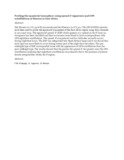| dc.contributor.author | D'ujanga, F.M. | |
| dc.contributor.author | Lugonvu, G. | |
| dc.contributor.author | Ndinya, B. | |
| dc.date.accessioned | 2023-07-06T11:21:47Z | |
| dc.date.available | 2023-07-06T11:21:47Z | |
| dc.date.issued | 2018-10-01 | |
| dc.identifier.uri | https://doi.org/10.1016/j.asr.2018.06.031 | |
| dc.identifier.uri | https://www.sciencedirect.com/science/article/abs/pii/S0273117718305155?via%3Dihub | |
| dc.identifier.uri | http://ir-library.mmust.ac.ke:8080/xmlui/handle/123456789/2252 | |
| dc.description.abstract | The Maseno (0.0°S, 34.6°E) ionosonde and the Mbarara (0.6°S, 30.7°E) GPS SCINDA receiver have been used to probe the equatorial ionosphere of the East Africa region using data obtained in 2012 and 2015. The equatorial spread-F (ESF) which appears as a spread on the F-layer on ionograms has been classified and their occurrence were found to have correspondence with GPS nighttime scintillations. The spread-F at equatorial and low-latitudes normally occurs during nighttime hours. The ESF was categorized into three distinct types and it was found that each type was more likely to occur during certain part of the night than the others. The pre-midnight type of ESF corresponded more with the appearance of GPS scintillations than the post-midnight type. The results showed that the greater the spread-F, the greater were the GPS scintillations implying that nighttime scintillations are primarily due to the presence of plasma density irregularities within the F-region. | en_US |
| dc.language.iso | en | en_US |
| dc.publisher | Advances in Space Research | en_US |
| dc.subject | Probing, equatorial, ionosphere, spread-F signatures, GPS scintillations, East Africa | en_US |
| dc.title | Probing the equatorial ionosphere using spread-F signatures and GPS scintillations at Maseno in East Africa | en_US |
| dc.type | Article | en_US |

